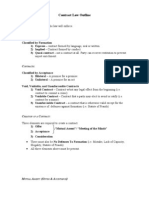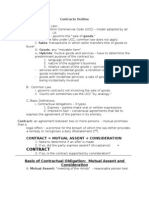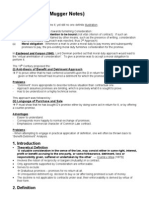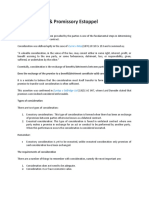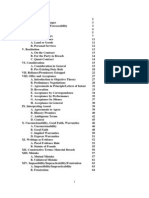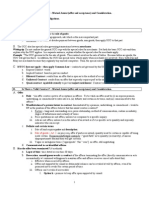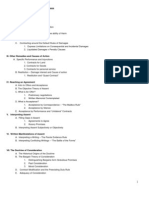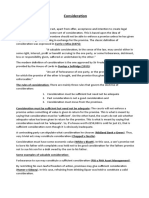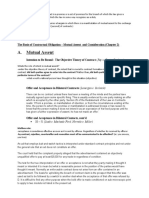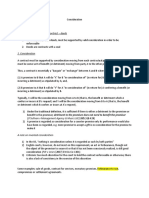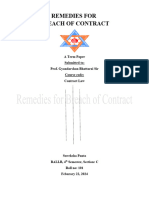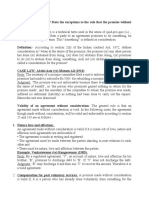Barnhizer Contractsi 1
Barnhizer Contractsi 1
Uploaded by
piddes1234Copyright:
Available Formats
Barnhizer Contractsi 1
Barnhizer Contractsi 1
Uploaded by
piddes1234Original Title
Copyright
Available Formats
Share this document
Did you find this document useful?
Is this content inappropriate?
Copyright:
Available Formats
Barnhizer Contractsi 1
Barnhizer Contractsi 1
Uploaded by
piddes1234Copyright:
Available Formats
CONTRACTS OUTLINE Professor Barnhizer Introduction to Contract Law 1.
Contract-a contract is a promise or set of promises, for breach of which the law gives a remedy, or the performance of which the law in some way recognizes as a duty. 2. Promise-a manifestation of intention to act or refrain from acting in a specified way, so made as to justify a promisee in understanding that a commitment has been made. 3. Agreement-a manifestation of mutual assent on the part of two or more persons. Damages for Breach of Contract Three damages Interests: 1. Expectation-In most breach of contract cases, the P will seek, and receive, his expectation interest. Ct attempts to put the P in the position he would have been in had the Contract been performed. P receives Benefit of Bargain. Including profits they would have made from the K. (value promised value received) + other losses costs avoided losses avoided = expectancy damages. 2. Reliance-Puts P in as good a position as he was in before the K was made. Out-of-pocket expenses or everything you have spent to comply with your obligations. (no recovery of profits you would have made, also does not include $ spent by third parties on your behalf.) 3. Restitution-Ct forces the D to pay to P amount = to the benefit which the defendant has received from the Ps performance. (what happens when WalMart sells broken TV). Three limitations on damages: 1. Foreseeability: Damages are not recoverable for loss that the party in breach did not have reason to foresee as a probable result of the breach when the K was made. Hadley v. Baxendale (mill shaft case). 2. Certainty: Damages are not recoverable for loss beyond an amount evidence permits to be established w/reasonable certainty. (Chicago Coliseum Club v. Dempsey). Policy reasons for limiting based on certainty: where profit is uncertain the ct doesnt want to award a greater amount than the P would have received if the K were performed. 3. Avoidability of harm: Damages are not recoverable for loss that the injured party could avoid w/out risk, burden, or humiliation. Must attempt to mitigate damages (reasonable efforts to avoid loss). (Rockingham County bridge case). Contracting around the default rules of damages: 1. Most K rules are default rules and therefore they can be contracted around by inserting an express clause to the contrary.
2. Liquidated damages clause: placed in the K itself to specify the consequences of the breach. As long as they are not excessive (penalty clause) they will be upheld. Not reasonably ascertainable at time of execution and at time of trial the projected damages agreed upon have to be similar to those that occurred. (Keeble v. Farren, ct did not hold up liquidated damages clause as didnt meet test above). 3. Penalty clauses are against public policy. 4. Punitive damages: not available in pure breach of K cases. Parties may attempt to contract around this bar by authorizing an arbitrator to award them. 11th Circuit Willoughby strongly suggests that courts will not allow this in pure breach of K. 5. Arbitration: Barnhizer says that this is a rival legal regime to courts or an extra-legal regime enforced by courts and approved by legislature (who could ban it). Most useful in dealing with disputes with industries that have large numbers of similar disputes that require expertise on that subject. Other Remedies and Causes of Action: remember that money damages are the normal remedy, but there are other remedies or extraordinary remedies that are used that are not $. Money damages are legal relief and others are equitable relief. 1. Specific Performance and Injunctions: SP orders a party to render the promised performance, while an injunction directs a party to refrain from doing something. Parties seeking an injunction or specific performance must prove that the good is unique, sentimental, peculiar or scarce and replacement not available. a) Land sale Contracts: specific performance is the default rule. Land is presumed unique. (Loveless v. Diehl) b) Sale of Goods: General rule is that SP will not be given if the subject matter is personality or goods. Exceptions: 1) no adequate remedy at law, 2) articles are unique, sentimental, peculiar, and 3) due to scarcity the chattel is not readily attainable. c) UCC 2-716: SP may be ordered where the goods are unique or in other proper circumstances. d) Ks for Personal Services: Cts almost never order specific performance of a K for personal services. (involuntary servitude, rights to ones body are inalienable.) i. 3 arguments against it: impracticability of enforcement, immorality of enforcement, and constent. ii. Negative covenants: agree not to perform elsewhere. Modern American Rule is that they will be upheld where person is of exceptional and unique knowledge, skill and ability in performing the service called for in K. (Dallas Cowboys v. Harris.) Restitution: Damage interest and Cause of Action: Restitution refers to (1) a remedy for breach of K by the non-breaching or the breaching party; and also (2) a separate noncontractual cause of action (also called a quantum merut or quasi-K). Regular Restitution: awarded as a damages interest for breach. Requires breaching party to pay to P amount = to the benefit which the defendant has
received from the Ps performance. (both parties must give back, as in TV example) Restitution in favor of the Breaching Party requires: (1) total breach; and (2) is unavailable if all that is left for the promisor to do is pay for the performance of the promissee. (purpose is to avoid unjust enrichment) Restitution where K never existed: Ks implied in law. Created to prevent unjust enrichment. NO actual contract. Legal fictions created by cts to justify an obligation to pay where one was never agreed to. (Cotnam: hurt motorist case, Martin: plagiarism book case. General rule is that volunteers have no right to restitution. Cotnum was an exception to rule as motorist was in a helpless condition.) Contract Formation Reaching an Agreement: 2 elements are needed to form K: 1) mutual assent of the parties to enter into a bargain; and 2) a showing that this mutual assent is the kind of assent that the law will deem an enforceable K. 1. Objective Theory of Assent: Meeting of the Minds:a partys intent is deemed to be what a reasonable person in the position of the other party would think that the 1st partys objective manifestation of intent meant. (Embry case). Offer and acceptance will create K if words or conduct by a party would be understood by a reasonable person as an objective manifestation of assent, and the other party actually understood the words to be an obj manifestation. (Embry)(Lucy: hidden joke case). An offer is a manifestation of willingness to enter into a bargain. 24. Acceptance is manifestation of assent to the terms thereof made by the offeree in a manner invited or required by the offer. Can be accepted only by person in whom the offeror intended to create a power of acceptance. Power of acceptance exists until rejection of a counter-offer, lapse of time, revocation by the offeror, death or incapacity of either party, or non-occurrence of condition of acceptance. 36. An option K can be used to hold the offer open for period of time. Such a K remains open until terms of the offer expire, so that if you bought and paid for option it remains open, but revocation by offeror would be breach. 2. Revocation: requires (1) offerors manifestation of intent not to enter into K, (2) of which the offeree has notice. UCC 2-205: offer to buy or sell good is irrevocable if (1) by a merchant, (2) signed writing, (3) gives assurance offer will be held open. 3. Mirror Image Rule: terms of acceptance must mirror terms of the offer (U.S. v. Braunstein). 4. Mailbox rule: acceptance is effective upon depositing the acceptance in the mail. A later transmitted rejection is ineffective, even if it gets there first. If the offeree mails a rejection first, the mailbox rule no longer applied and it depends on which arrives 1st. 5. Acceptance by Silence: general rule is that regardless of prior transactions, if goods or services are given and the person has reason to believe that the sender will take silence as an acceptance of the goods or services, the receiver has to notify the sender that they do not accept.
6. Acceptance by Performance and Unilateral Ks: In a Unilateral K, acceptance by performance is required (Carlill v. Carbolic Smoke Ball Co.) However, in a Bilateral K acceptance by promise will suffice. a. Difficulties with offers that stipulate to acceptance by performance: i. offers that are irrevocable may be revoked up until time they are accepted. If a K has not been accepted before revocation, then when performance is rendered there may be no recovery available. ii. Performance constituting acceptance has never been defined as part performance of the requested act or acts. The consideration requested is complete performance. iii. Since Offeree not bound until performance is complete, if perf is not completed they may be out a great deal. However, keep in mind that with Ks accepted by promise, the offeree is also liable for non-performance. IN addition, acceptance by perf gives the offeree complete discretion. Lastly, either party is free to require a counter-promise. Interpreting Assent: Cts are reluctant to do anything. Never want to create a K where none existed, but will tolerate some degree of indefiniteness where evidence indicates parties intended to K and there is some means of resolving the dispute. 1. Filling gaps in assent: It is a general rule that no K comes into being if (1) a material aspect of the agreement is left indefinite by the parties, and (2) the uncertainty cannot be resolved by the process of interpretation. All Ks have gaps issues that the parties failed to clarify or foresee at the time of contracting. Interpretation resolves those gaps. i. Material terms: term is material if it is an important component of the K, gauged by the facts and circumstances. Time, place of performance, price, and subject matter are often material terms. ii. Rest. and UCC: both say that a K should be treated as reasonably certain and enforceable if the language: 1. interpreted in context of surrounding facts and circumstances; 2. provides enough content to establish an intent to K; 3. cts will supply a reasonable term (implied by law) 204. iii. Sun Printing case: K left two open terms (price after Dec and length of time price would govern). Ct could not supply additional reasonable terms to resolve the ambiguity because that the indefiniteness indicated that the parties did not intend to create a K after Dec. 1. Cure by concession: conceding to the ambiguous terms based upon the most favorable terms of the K to the other party.
iv. Many types of indefiniteness: omitted terms, illusory promises, vagueness, ambiguity, unresolved terms. v. UCC 2-204: permits enforcement where 1 or more terms are left open so long as (1) the parties intended to K, and (2) there is a reasonably certain basis for giving a remedy. (when the parties have not agreed to an essential term a reasonable term will be supplied by the ct). vi. Texaco v. Pennzoil: distinction between indefiniteness and arguments about formal contracts contemplated/ agreements to agree. Texaco cant create indefiniteness by claiming that there were other terms that Pennzoil and Getty should have included in their K. vii. Illusory Promise: promise is illusory if the promisor retains unlimited discretion over whether to perform the promise. If it really is illusory the ct will not find a K. The cts, when unsure, can imply terms to cure the problem of an illusory promise as long as it is clear the parties intended to K. 1. Wood v. Lucy: implying best efforts clause to resolve illusory nature of promise 2. UCC 2-306: a lawful agreement by either the seller or the buyer for exclusive dealing in the kind of goods concerned imposes unless otherwise agreed, an obligation by the seller to use best efforts to supply the goods and by the buyer to use best efforts to promote their sale. 3. Rebuttable presumption that parties intend a best efforts caluse whenever they execute a requirement or outputs K. Interpreting assent subjectively or objectively: American K law has adopted the objective theory of assent. Hotchkiss v. National City Bank: Judge Learned Hand states a K has nothing to do with the personal, or individual, intent of the parties. viii. Subjective: secret/individual intent ix. General Rule: the subjective agreement of the parties will be honored, but where there is no meeting of the minds, either party will be entitled to rely on the reasonable meaning of the terms of their K that were expressed. x. Raffles case: Peerless ship case. Two ships named Peerless and P meant one and D meant the other. Illustrates that the Objective theory of assent does not resolve all indefiniteness and where the indefiniteness of a material term cannot be resolved, there is no K. xi. Latent v. Patent ambiguity: 1. Latent ambiguity: such that no one can know what that term means.
2. Patent ambiguity: when there are two or more possible meanings for a given term (more common). xii. Interpretation of Ks that are objectively ambiguous: 1. Rules in aid of Interpretation: a. words/conduct are interpreted in light of the surrounding facts and circumstances, purpose of the parties in King is given great weight. b. Writing interpreted as a whole and all writings that are part of the same transaction are interpreted together. c. Unless parties show a different intent: i. where language has generally prevailing meaning, the K will be interpreted in light of that meaning; but ii. technical terms within a specific trade or usage are accorded their technical meanings in transactions w/in that specific trade or usage. d. course of performance is given great weight e. interpret manifestations of assent consistently with one another and with any relevant course of performance, course of dealing, or usuage of trade. 2. UCC: things to look to in order to find meaning (order of importance): language of K, course of negotiations, course of perf, course of dealing, usage of trade. 3. Chicken case: stewers v. broilers. P has burden of Proof to show that its interpretation controls; D not bound by trade usage b/c no reason to know of technical. 2. Written Manifestations of assent: a. Contemporary 2-step rule: Ct is likely to allow in extrinsic evidence of integration or ambiguity, for the purpose of determining the meaning of the terms of the K, so long as those terms are reasonably susceptible to the meaning suggested by the parol evidence: i. if the K is integrated and unambiguous, the inquiry ends and the ct interprets the K. ii. if the ct determines that the K is not integrated or is ambiguous, then it allows the parties to submit parol evidence to the jury to determine which meaning the parties intended. (this two step rule is from Pacific Gas) b. 4 Corners rule: under this rule judges look only to the 4 corners of the agreement and do not admit extrinsic evidence of ambiguity. i. never really worked in practice (evidence of two ships Peerless is necessary for the determination.
ii. Idea of a plain and unambiguous K, determinable on its face, is still there and judges will be reluctant to allow in parol evidence where it is inconceivable that the evidence could be consistent with the meanings of the writing. c. Interpreting a writing: The Parol Evidence Rule: to the extent that the parties execute a writing that is and is intended to be a final expression of their agreement (integrated), no proof of parol evidence may be admitted to supplement, explain, or contradict the unambiguous terms of that agreement: i. However, to the extent that the writing is not a final, complete, and unambiguous expression of the agreement, consistent, but not contradictory, parol evidence may be admitted to supplement or explain those parts of the writing that have not been finally expressed. ii. If judge is not convinced it is integrated, the writing is not protected by the PE rule and may be varied or contradicted by any extrinsic evidence which the jury elects to credit. iii. Test for Completely Integrated: a total integration is a document that is not only a final expression of agreement, but that is also intended to include all details of the agreement. iv. Thompson case: writing was silent as to a warranty, and therefore the PE rule forbids the use of evidence to add such a warranty. v. Types of Parol Evidence: 1. contemporaneous prior or oral agreements 2. prior written agreements 3. contemporaneous written agreements would likely be part of K 4. subsequent writings or oral agreements are modifications. vi. Purpose of Parol Evidence rule is to keep out frauds or terms that were never part of the actual K between the parties. vii. Remember that PE may be freely used to clarify an ambiguity in the terms of the integrated writing. PE may be freely received to prove trade custom or course of dealings as between the parties.PE may not be used to clarify a term which is defined within the integrated writing. d. Interpreting conflicting writings: Battle of the Forms: remember that this topic only applies when merchants are sending pre-printed form agreements to one another. i. recall mirror image rule ii. Last shot rule: where parties send competing form offers and acceptance back and forth, each different form operates as a rejection of the preceding offer and makes a new counter-offer. This process does not end until one party starts performance,
which is deemed an acceptance of the terms of the last communication from the other party. iii. UCC 2-207 rejects both the mirror image rule and the last shot rule: a definite and seasonable expression of acceptance is deemed to be an acceptance and any additional or different terms are proposals for new terms that are incorporated in the contract unless : the contract is not between merchants (addl terms not in K, but conduct is sufficient to establish K); OR the K is between merchants and: (1) the offer is expressly limited to its terms, (2) terms materially alter offer, (2) notice of objection by offeror. But, if acceptance is expressly made conditional on assent to the additional terms, it operates as a counteroffer, in which case: if clear manifestation of acceptance of diff terms by offeror/ counterofferee, then K on counter offerors terms If no acceptance but performance: K under 2-207(3): which supplies the terms and states that they are (1) those on which the parties agree, and (2) those supplied as gap-fillers by UCC.If no acceptance or Perf: no K iv. Standard for determining if acceptance is actually a conditional acceptance/counteroffer: Ct requires offeree to demonstrate an unwillingness to proceed w/ transaction unless additional or different terms are included in K. Puts burden on the party asking the ct to enforce its preferred term to prove that a particular term is part of the K. 3. Requiring a writing: Statute of Frauds: Ks within the scope of the S of Fs may not be enforced unless a memo of it is written and signed by the party to be charged. The intention of the SOF is to prevent fraud. i. Three step analysis: 1. Is the alleged oral K of the type covered by the S of Fs? a. Ks for the sale of Land or an interest in land b. Ks not to be performed within 1 year of the making thereof c. Ks for the sale of goods of a value of $500 or more. 2. Is there a sufficient writing evidencing the K? a. You have to have some written evidence of the alleged oral agreement: written memo of K (Schwedes). With respect to oral Ks, this evidence is not a K. b. The writing must contain most or all of the material terms of the K and must be signed by the party to be charged. (Parma Tile case: can be a symbol and only has to be signed by the party who is saying there is no K. If K is
contained in several writings only one has to be signed. c. UCC standard: writing only has to specify the quantity and has to indicate that a K for sale has been made between the parties. d. UCC exception to signature requirement: 2202: a K for sale of goods is enforceable against a party who does not sign if both parties are merchants and w/in a reasonable time of oral K one sends a written confirmation of the K to the other and is signed by the party who did not sign. In addition, the recipient knows the contents of the mail. e. UCC 10 day exception: if within 10 days after receiving unsolicited goods, party does not send objection to the order there is evidence that there may have been a K. (between merchants only) 3. If you dont have a sufficient writing evidencing the K, is the writing requirement excused for some reason? a. Partial performance must be substantial and directly refer to the terms of the K sought to be enforced. (Riley case) b. Detrimental reliance does not really excusing the K from the S of Fs, but rather seeking a claim in Promissory estoppel-an equitable action where there is no K- for reliance damages incurred by reasonable reliance on an unenforceable promise by the promisor upon which the promisor expected the promisee to rely. (Riley and Boone both got their damages awards under this theory). c. Complete performance of 1 parties obligation to K not to be performed within one year. Multi-party Transactions 1. Assignment-a transfer of rights in which the person who assigns a contractual right is called the obligee and, upon assignment, becomes the assignor. The person to whom the contractual right is transferred/assigned is called the assignee and the other party to K, whose contractual duty is transferred to the assignee, is called the obligor. 2. Delegation-a transfer of duties in which the person who delegates the contractual duty is called the obligor under the K and becomes the delegator of the duty. The person who assumes the delegated contractual duty is called the delegate , and the other party to the K, whose right to performance has been delegated, is called the obligee.
b. Law favors transferability of contractual rights and obligations. c. General rule: Unless a K prohibits a party from transferring their rights and duties under that K, or the nature of the K is such that assignment or delegation would: 1. impair the other parties reasonable expectations under the K, 2. or offend public policy, THEN a party has the power to transfer through Assignment or Delegation! d. Nature of Assignments: assignment is a voluntary manifestation of intention by the holder of an existing right to make an immediate transfer of that right to another person. e. Two factor test for Assignments: 1. Assignor must voluntarily manifest assent to assign the right, and the assignee must voluntarily manifest an intent to accept the assignment; 2. Immediate transfer of an existing right that dispossesses obligee of identified interest or some part thereof and vests indefeasible title in the transferee. (Kelly) f. Restrictions on Assignment: No assignment if K prohibits it; assignment would materially alter obligors duty, increase burden or risk, impair obligors prospects of getting return performance, or otherwise substantially reducing the value of the K to the obligor; or assignment is contrary to public interest (Nance). g. Effect of assignment: assignee substitutes for assignor as person to whom performance is owed and may enforce the K to the same extent that the assignor could have enforced it. Assignee cannot assert any greater rights than the assignor had and the obligor can assert any defenses against the assignee he/she had against the assignor. h. Delegation: duties of personal nature may not be delegated, otherwise law favors delegation. Major difference with assignment is that the assignee substitutes for the assignor, but the delegator is still liable to complete performance of the delegated duties if the delegate fails to do so. i. Grounds for Insecurity: when one party to K has grounds for insecurity following an A or D by the other party, they may demand adequate assurances of performance. i. Manifesting assent through an agent: An agency relationship is created when one person (the agent) consents to act on behalf of and subject to the control of another (the principal). i. 3 Elements: 1. agency is a fiduciary relation which results from the manifestation of consent by one person (principal) to another (agent), 2. that the agent shall act on the principals behalf and subject to the principals control, 3. and the agent consents to the relationship.
10
j. Agent may bind the principal to Ks that are within the scope of the agents actual or apparent authority. k. Three types of authority: ( from New England Training case) 1. Express authority: explicit written or oral expression. Actual authority. 2. Implied authority: communications from P to A. By custom, conduct, etc the P has communicated authority to A. Inferred from circumstances and facts. Actual authority. 3. Apparent Authority: does not involve an actual delegation of authority from the P to the A. It is created through the conduct of the P to a third party which reasonably leads that 3rd party to rely on the appearance that the A has authority. Not communicated to A. Doesnt matter what the P says to the A (objective manifestation to 3rd party). l. Limits of agents authority: As authority is limited by the terms of the delegation of authority and (in the case of apparent) by the reasonableness of the 3rd partys reliance on the agents apparent authority to undertake some act. (Jennings case) Public Policy Issues Note: Professor Barnhizer generally dislikes any courts use of public policy as justification for any of its decisions. Too often it is merely an attempt or shorthand method for a court to legislate a result that it prefers. Con Arguments-courts are generally not equipped to handle issues of public policy for the following reasons: 1. No expertise and limited record. As the Johnson court noted, legislatures have the luxury of listening to and examining all available facts on an issue 2. Public policy justifications have a huge potential for abuse because courts can abdicate their role as protector of the status quo and follow popular or unlegislated rule, and courts can legislate form the bench Pro Arguments-can serve very important purposes in judicial decisions by helping a court maintain their legitimacy when the outcome required by law is universally disliked 1. This may include overriding the right of a party who would otherwise prevail. 2. Japanese Internment Case where the court justified the holding of Americans of Japanese descent in internment camps during WWII 3. Public policy can occasionally act as a safety valve by permitting courts to alter a logically compelling outcome when it just doesnt fit within our system of legal theories 4. Public policy also helps us to recognize that our system of legal rules, principles, and theories isnt perfect
11
5. The trouble with public policy justifications is that the rule of law compels us to follow the law, and not to make exceptions for the sake of perceived intellectual neatness 6. The ultimate question: When, if ever, would a public policy end contrary to our established legal rights be justified? Application to cases1. Shaheen v. Knight (sterilization case)-the obligation of physician was not based upon a K, and there was no warranty of cure. Additionally, awarding damages for the birth of a healthy baby is against public policy 2. In Re Baby M (surrogate case)-K was disallowed because of its terms (allowing payment of $10,000 for birth of healthy baby, less if stillborn, money to be paid at birth, etc.). Allowing the K would have the public policy effect of creating K duties based upon status, and our society has moved from status-based to K-based duties. Note: Be aware of the pro and con arguments for allowing or failing to allow K to apply in surrogate cases. Restatement 2nd1. Section 178-When a term is unenforceable on grounds of public policy a. If legislation says so or the interest is outweighted by public policy b. Account is taken of the parties expectations, resulting forfeiture, public interest, strength of policy as evidenced by legislation, case law, likelihood that refusal to enforce the term will further public policy, seriousness of misconduct 2. Section 179-Bases of public policy a. The court may decide not to enforce contracts based on legislation because of a need to protect public welfare (trade, family relations, other protected interests)
12
You might also like
- 1L Contracts OutlineDocument10 pages1L Contracts OutlineEvangelides100% (4)
- Surety Bond TemplateDocument10 pagesSurety Bond TemplateJohn Ox96% (27)
- Contracts FULL Outline For MBEDocument12 pagesContracts FULL Outline For MBEMegan KelbermanNo ratings yet
- Hawkins V McgeeDocument3 pagesHawkins V Mcgeeandrearachel100% (2)
- Contract Law OutlineDocument8 pagesContract Law OutlineJ0221No ratings yet
- Contracts OutlineDocument12 pagesContracts Outlineericachavez83% (18)
- Contracts OutlineDocument22 pagesContracts OutlineddefinoNo ratings yet
- Full Contracts OutlineDocument42 pagesFull Contracts OutlineDanielle Easton88% (8)
- Department of Finance vs. Dela Cruz - DigestDocument1 pageDepartment of Finance vs. Dela Cruz - DigestRoxanne PeñaNo ratings yet
- Ks Outline: 1.1 Introduction To K LawDocument38 pagesKs Outline: 1.1 Introduction To K LawTara StarkNo ratings yet
- Consideration Mugger NotesDocument14 pagesConsideration Mugger NotesDonald TayNo ratings yet
- Contract Law AssignmentDocument10 pagesContract Law AssignmentSyed Muhammad Ahmed100% (1)
- PMBR Contracts IDocument52 pagesPMBR Contracts IjackojidemasiadoNo ratings yet
- Contract Unit 4 Ranjana AnjanaDocument13 pagesContract Unit 4 Ranjana Anjanasabkajob jobNo ratings yet
- Consideration & Promissory EstoppelDocument6 pagesConsideration & Promissory EstoppelSultan Mughal100% (1)
- K - SamoutlineDocument3 pagesK - SamoutlineashleighNo ratings yet
- Contracts Outline IIDocument23 pagesContracts Outline IIjamesbeaudoinNo ratings yet
- CDocument11 pagesCAlexNo ratings yet
- Contracts Final OutlineDocument19 pagesContracts Final OutlineCatherine Merrill100% (1)
- Contract LawDocument9 pagesContract LawAreeba TanveerNo ratings yet
- Contracts Harvard Ferrell Fall2004Document29 pagesContracts Harvard Ferrell Fall2004thebull315No ratings yet
- Ecm Pro 063763Document65 pagesEcm Pro 063763José LuisNo ratings yet
- 4. ConsiderationDocument24 pages4. Considerationtimilehimdk25No ratings yet
- Real Estate OutlineDocument67 pagesReal Estate OutlineRichNo ratings yet
- Contracts Outline - CO - Kaal - Spring 2010Document9 pagesContracts Outline - CO - Kaal - Spring 2010Chris OdomNo ratings yet
- Contract LawDocument5 pagesContract LawSyed Muhammad AhmedNo ratings yet
- Contracts OutlineDocument4 pagesContracts OutlineTheofano FrankNo ratings yet
- Consideration. Version 2022 23Document8 pagesConsideration. Version 2022 23sakiburrohman11No ratings yet
- Contracts Outline - Siegelman - Fall 2011Document71 pagesContracts Outline - Siegelman - Fall 2011diemericNo ratings yet
- Consideration: The Rules of Consideration: There Are Mainly Three Rules That Govern The Doctrine ofDocument4 pagesConsideration: The Rules of Consideration: There Are Mainly Three Rules That Govern The Doctrine ofMehedi Hasan ShaikotNo ratings yet
- Contracts OutlineDocument53 pagesContracts OutlineavaasiaNo ratings yet
- Contracts OutlineDocument22 pagesContracts Outlinejs804No ratings yet
- A. Mutual Assent: Particular Terms of The Contract?Document6 pagesA. Mutual Assent: Particular Terms of The Contract?Chad OlsonNo ratings yet
- Rules After Midterm: Consideration: Consists Either in Some Right, Interest, or Benefit Accruing To One Party or SomeDocument51 pagesRules After Midterm: Consideration: Consists Either in Some Right, Interest, or Benefit Accruing To One Party or SomeJosh GoldsboroughNo ratings yet
- Outlines For ExamDocument13 pagesOutlines For Examainash_asselNo ratings yet
- Intro To Contract Law: 1. What Is A Contract?Document24 pagesIntro To Contract Law: 1. What Is A Contract?misterbabyNo ratings yet
- NCDC Contracts OutlineDocument7 pagesNCDC Contracts Outlinetuckerj1No ratings yet
- Contracts OutlineDocument39 pagesContracts OutlinesienaNo ratings yet
- Final Contracts OutlineDocument61 pagesFinal Contracts OutlineGrant Burchfield100% (1)
- ConsiderationDocument22 pagesConsiderationcwangheichan100% (1)
- Acceptance & Consideration 3Document5 pagesAcceptance & Consideration 3henry chandlorNo ratings yet
- 211-Chaster - Law 108A - MidtermDocument48 pages211-Chaster - Law 108A - MidtermJjjjmmmmNo ratings yet
- Contracts Outline Schooner 2014-15Document35 pagesContracts Outline Schooner 2014-15mirandaturner55No ratings yet
- LAW 13 Notes - Chapter 9 & 10Document7 pagesLAW 13 Notes - Chapter 9 & 10Jacqueline DeStefanoNo ratings yet
- Law School - Contracts NotesDocument17 pagesLaw School - Contracts NotesKJ100% (2)
- Performance, Breach, Remidies, Damages Sir Notes 6Document10 pagesPerformance, Breach, Remidies, Damages Sir Notes 6ahmadabrarrasool31No ratings yet
- Remedies in Contract LawDocument11 pagesRemedies in Contract LawjaybotommyNo ratings yet
- Contracts Outline - Alces 2012Document15 pagesContracts Outline - Alces 2012dogsgonewildNo ratings yet
- Contract Law - Term PaperDocument10 pagesContract Law - Term PaperSuveksha PantaNo ratings yet
- Obligations Outline CDocument42 pagesObligations Outline Ctml.subberNo ratings yet
- Contract Law 2 Short NotesDocument9 pagesContract Law 2 Short NotesWaseem Ahmad QurashiNo ratings yet
- Contracts Law OutlineDocument24 pagesContracts Law OutlineffbugbuggerNo ratings yet
- Null 8Document40 pagesNull 8almak6535No ratings yet
- Contract Reading NotesDocument241 pagesContract Reading Noteshardfest21No ratings yet
- Impeachable+dispositions SummaryDocument7 pagesImpeachable+dispositions SummaryJoshua OnckerNo ratings yet
- Contract 1Document110 pagesContract 1yogeetha sai100% (1)
- Importance of ConsiderationDocument15 pagesImportance of ConsiderationASIF RAFIQUE BHATTI100% (7)
- 1588863595law of Contract AssignmentDocument8 pages1588863595law of Contract AssignmentMoyosore OderindeNo ratings yet
- Assignment Business LawDocument26 pagesAssignment Business Lawzakuan79No ratings yet
- Cape Law: Texts and Cases - Contract Law, Tort Law, and Real PropertyFrom EverandCape Law: Texts and Cases - Contract Law, Tort Law, and Real PropertyNo ratings yet
- Vitto Vs CADocument1 pageVitto Vs CARafael SoroNo ratings yet
- United States v. Tsosie, 10th Cir. (2008)Document19 pagesUnited States v. Tsosie, 10th Cir. (2008)Scribd Government DocsNo ratings yet
- People V Daniel AC Disregard of Rank, Age, Sex & DwellingDocument2 pagesPeople V Daniel AC Disregard of Rank, Age, Sex & Dwellingjason caballeroNo ratings yet
- Rozell v. Thomas Et Al (INMATE1) - Document No. 3Document5 pagesRozell v. Thomas Et Al (INMATE1) - Document No. 3Justia.comNo ratings yet
- Narciso Vs GarciaDocument3 pagesNarciso Vs GarciaJerick Christian P DagdaganNo ratings yet
- Yonaha V CA G.R. No. 112346. March 29 1996Document2 pagesYonaha V CA G.R. No. 112346. March 29 1996Plok PlotNo ratings yet
- Negligence NotesDocument66 pagesNegligence Notesbantu EricNo ratings yet
- Williams v. Ziebart International Corporation Et Al - Document No. 2Document5 pagesWilliams v. Ziebart International Corporation Et Al - Document No. 2Justia.comNo ratings yet
- Aguiar Answer Brief (Fla. 4th DCA)Document28 pagesAguiar Answer Brief (Fla. 4th DCA)DanielWeingerNo ratings yet
- G.R. No. 200558 - Pangasinan v. Disonglo-AlmazoraDocument10 pagesG.R. No. 200558 - Pangasinan v. Disonglo-AlmazoraFranco AguiluzNo ratings yet
- 26-OrDER Granting Motion Amend and Deny Motion DismissDocument31 pages26-OrDER Granting Motion Amend and Deny Motion DismissAnonymous 0HLz3hF100% (1)
- Defendant's Answer in Cole v. Gene by GeneDocument14 pagesDefendant's Answer in Cole v. Gene by Genemnm3eNo ratings yet
- CJ SyllabusDocument38 pagesCJ SyllabusHamadNo ratings yet
- 1791 Constitution of May 3, 1791Document10 pages1791 Constitution of May 3, 1791Sabin PandeleaNo ratings yet
- 20 - Yujuico vs. AtienzaDocument4 pages20 - Yujuico vs. AtienzaAngelo Raphael B. Delmundo100% (1)
- 2015 PALS Civil Law Case Syllabi Part 1Document175 pages2015 PALS Civil Law Case Syllabi Part 1arloNo ratings yet
- United States v. David Charles McClinton, 940 F.2d 653, 4th Cir. (1991)Document5 pagesUnited States v. David Charles McClinton, 940 F.2d 653, 4th Cir. (1991)Scribd Government DocsNo ratings yet
- Estrada v. Sto DomingoDocument3 pagesEstrada v. Sto Domingoanne labuyoNo ratings yet
- Melliza v. City of Iloilo (1968)Document7 pagesMelliza v. City of Iloilo (1968)kfv05No ratings yet
- DIGEST - Alcantara V MallionDocument1 pageDIGEST - Alcantara V MallionMeeko BeltranNo ratings yet
- Loring P. Litchfield v. Commissioner of Internal Revenue, 330 F.2d 509, 1st Cir. (1964)Document3 pagesLoring P. Litchfield v. Commissioner of Internal Revenue, 330 F.2d 509, 1st Cir. (1964)Scribd Government DocsNo ratings yet
- 4 Toledo Banaga Vs CADocument13 pages4 Toledo Banaga Vs CAAngelicaAldayMacasadiaNo ratings yet
- BSF Head Constable Application FormDocument17 pagesBSF Head Constable Application FormAnand Nair ABpositveNo ratings yet
- BailDocument19 pagesBailRajendra SinghNo ratings yet
- Powers of The Registrar, Deputy Registrar and Assistant RegistrarDocument7 pagesPowers of The Registrar, Deputy Registrar and Assistant RegistrarayushNo ratings yet
- ABRC2016.Pointers in Legal and Judicial Ethics CombinedDocument36 pagesABRC2016.Pointers in Legal and Judicial Ethics CombinedKlarence OrjaloNo ratings yet
- Tarver v. Tarver, 34 U.S. 174 (1835)Document6 pagesTarver v. Tarver, 34 U.S. 174 (1835)Scribd Government DocsNo ratings yet




